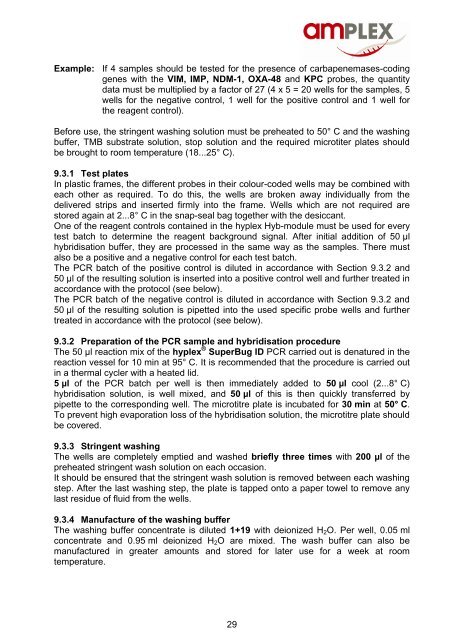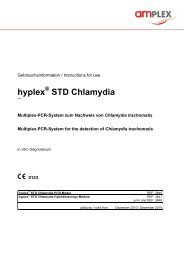hyplex SuperBug ID
hyplex SuperBug ID
hyplex SuperBug ID
Create successful ePaper yourself
Turn your PDF publications into a flip-book with our unique Google optimized e-Paper software.
Example: If 4 samples should be tested for the presence of carbapenemases-coding<br />
genes with the VIM, IMP, NDM-1, OXA-48 and KPC probes, the quantity<br />
data must be multiplied by a factor of 27 (4 x 5 = 20 wells for the samples, 5<br />
wells for the negative control, 1 well for the positive control and 1 well for<br />
the reagent control).<br />
Before use, the stringent washing solution must be preheated to 50° C and the washing<br />
buffer, TMB substrate solution, stop solution and the required microtiter plates should<br />
be brought to room temperature (18...25° C).<br />
9.3.1 Test plates<br />
In plastic frames, the different probes in their colour-coded wells may be combined with<br />
each other as required. To do this, the wells are broken away individually from the<br />
delivered strips and inserted firmly into the frame. Wells which are not required are<br />
stored again at 2...8° C in the snap-seal bag together with the desiccant.<br />
One of the reagent controls contained in the <strong>hyplex</strong> Hyb-module must be used for every<br />
test batch to determine the reagent background signal. After initial addition of 50 µl<br />
hybridisation buffer, they are processed in the same way as the samples. There must<br />
also be a positive and a negative control for each test batch.<br />
The PCR batch of the positive control is diluted in accordance with Section 9.3.2 and<br />
50 µl of the resulting solution is inserted into a positive control well and further treated in<br />
accordance with the protocol (see below).<br />
The PCR batch of the negative control is diluted in accordance with Section 9.3.2 and<br />
50 µl of the resulting solution is pipetted into the used specific probe wells and further<br />
treated in accordance with the protocol (see below).<br />
9.3.2 Preparation of the PCR sample and hybridisation procedure<br />
The 50 µl reaction mix of the <strong>hyplex</strong> ® <strong>SuperBug</strong> <strong>ID</strong> PCR carried out is denatured in the<br />
reaction vessel for 10 min at 95° C. It is recommended that the procedure is carried out<br />
in a thermal cycler with a heated lid.<br />
5 µl of the PCR batch per well is then immediately added to 50 µl cool (2...8° C)<br />
hybridisation solution, is well mixed, and 50 µl of this is then quickly transferred by<br />
pipette to the corresponding well. The microtitre plate is incubated for 30 min at 50° C.<br />
To prevent high evaporation loss of the hybridisation solution, the microtitre plate should<br />
be covered.<br />
9.3.3 Stringent washing<br />
The wells are completely emptied and washed briefly three times with 200 µl of the<br />
preheated stringent wash solution on each occasion.<br />
It should be ensured that the stringent wash solution is removed between each washing<br />
step. After the last washing step, the plate is tapped onto a paper towel to remove any<br />
last residue of fluid from the wells.<br />
9.3.4 Manufacture of the washing buffer<br />
The washing buffer concentrate is diluted 1+19 with deionized H 2 O. Per well, 0.05 ml<br />
concentrate and 0.95 ml deionized H 2 O are mixed. The wash buffer can also be<br />
manufactured in greater amounts and stored for later use for a week at room<br />
temperature.<br />
29




